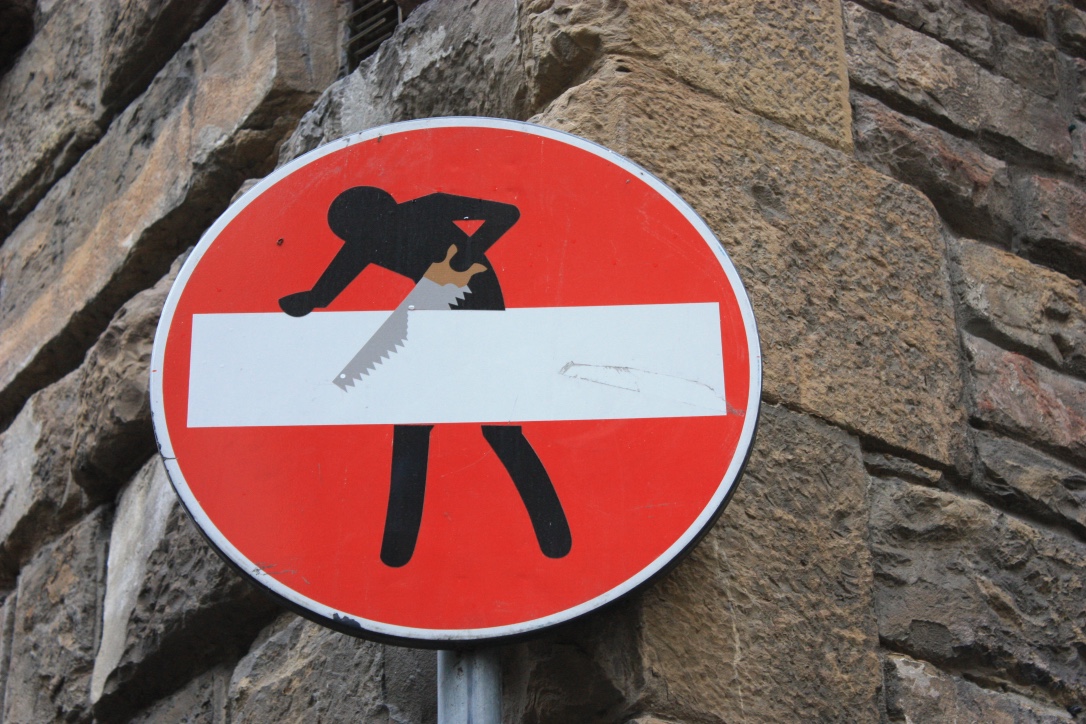 How to cut railway sleepers
How to cut railway sleepers
What tools can I use to cut railway sleepers?
Which railway sleepers are easiest / hardest to cut?
Urban myths
Can you believe it?
What tools can I use to cut railway sleepers?
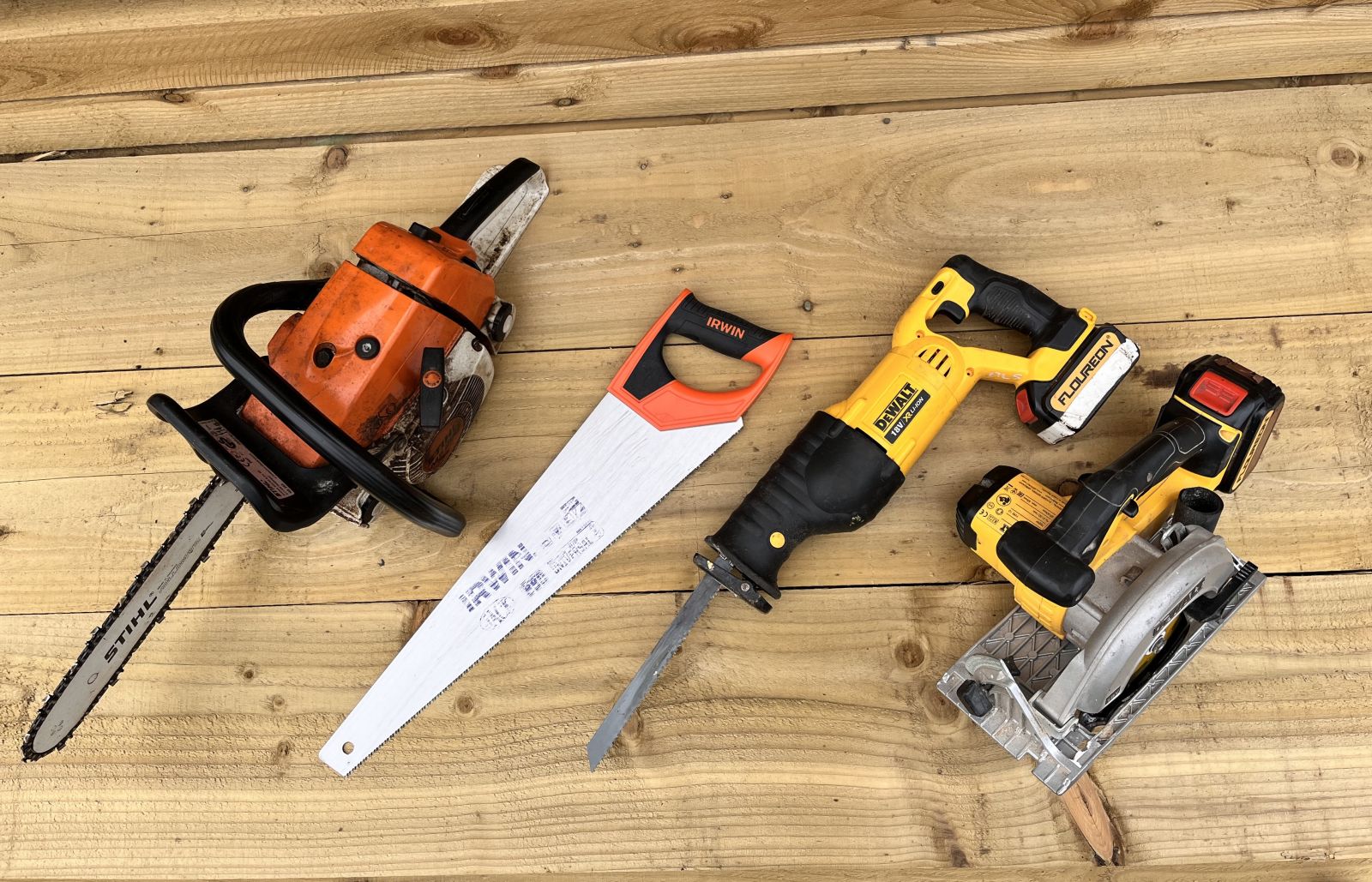 In a perfect world you wouldn't have to cut! You would create your wonderful railway sleeper project with standard size railway sleeper lengths that require no cutting. If possible try and limit the amount of cuts you need to do by planning a design that fits with the size of our railway sleepers. Unfortunately, gardens, walls, steps & patios don't always come in 'off the shelf' sizes, so you will normally end up having to get out your cutting equipment. But fear not, railway sleepers are ultimately big blocks of timber that simply require the right tool for the job!
In a perfect world you wouldn't have to cut! You would create your wonderful railway sleeper project with standard size railway sleeper lengths that require no cutting. If possible try and limit the amount of cuts you need to do by planning a design that fits with the size of our railway sleepers. Unfortunately, gardens, walls, steps & patios don't always come in 'off the shelf' sizes, so you will normally end up having to get out your cutting equipment. But fear not, railway sleepers are ultimately big blocks of timber that simply require the right tool for the job!
General tips:
1) Cutting railway sleepers can be quite messy and dusty, so make sure you have decent ventilation (outside is best to avoid breathing particles of sawdust) and wear appropriate protective protective clothing including goggles, a dust mask, ear defenders and gloves. If you are working on your knees whilst cutting the railway sleepers, maybe consider getting some protective knee pads to lessen any strain.
2) Whatever tool you use, make sure that the blade is as sharp as possible. A blunt blade can be dangerous, time consuming and can lead to damage to both the railway sleeper and yourself. Change or sharpen your blade frequently, so that it cuts accurately.
3) Draw out your measurements in advance so that you have a precise cutting line to follow. That helps in the middle of a swirl of sawdust.
4) If your tool is electric and needs an extension cable, make sure you use one with the correct rating, to avoid tripping the cable, or indeed the whole house. It goes without saying that cutting through the cable is never very productive.
5) Children love to be part of projects in the garden, but make sure they keep clear when you are cutting. Although we sell metal connector plates and screws, they are not designed for fastening children's limbs back together again.
1) Handsaw
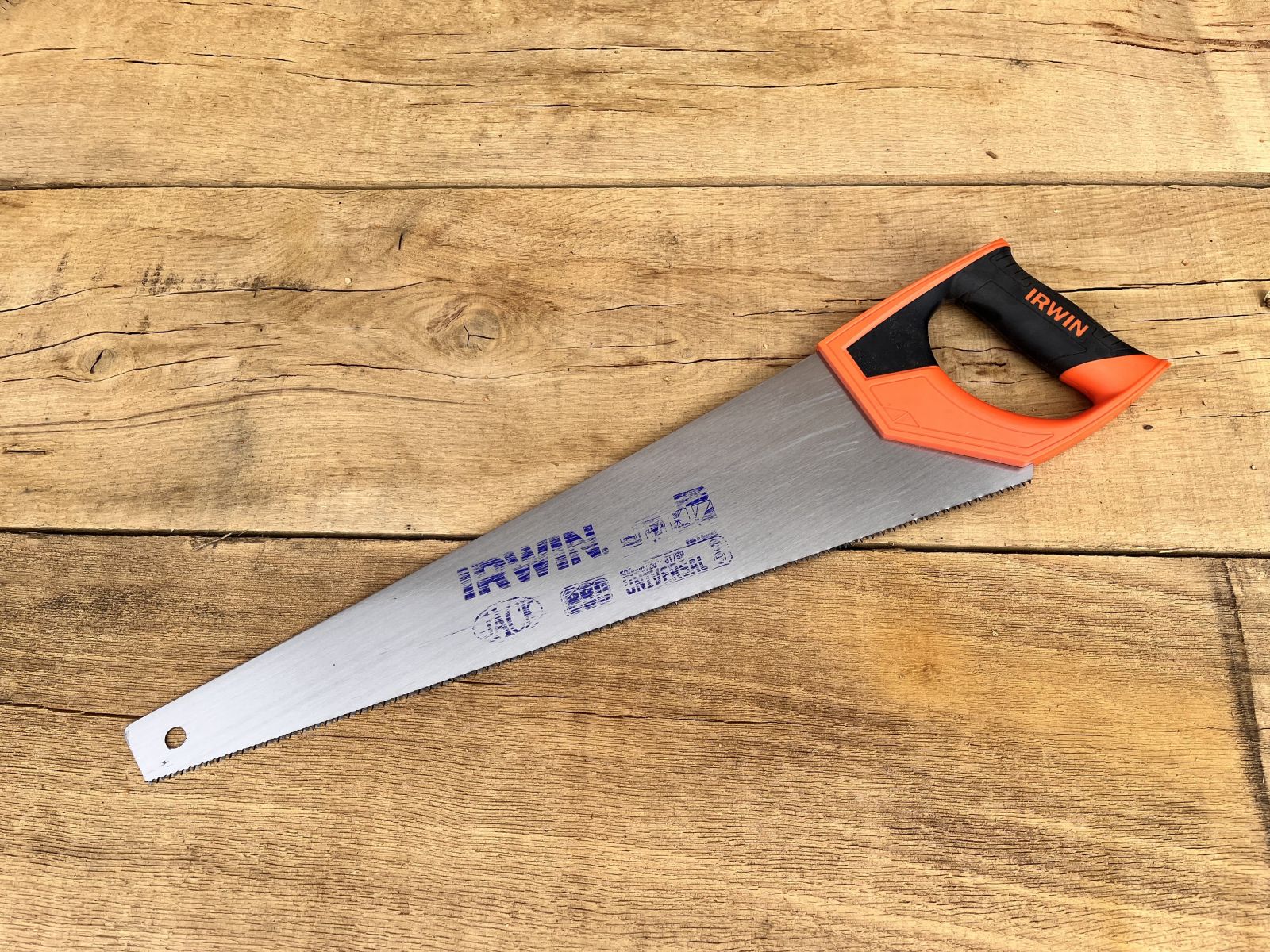 It's safe, quiet and cheap, but ultimately it comes down to how many cuts you've got to make. If it's just a couple, then a new, sharp handsaw should be fine. If you've got multiple railway sleepers to cut, then a powered saw would probably be best. A handsaw can be used to easily cut through softwoods and is useful for cutting through central sections that a circular saw blade might not reach.
It's safe, quiet and cheap, but ultimately it comes down to how many cuts you've got to make. If it's just a couple, then a new, sharp handsaw should be fine. If you've got multiple railway sleepers to cut, then a powered saw would probably be best. A handsaw can be used to easily cut through softwoods and is useful for cutting through central sections that a circular saw blade might not reach. 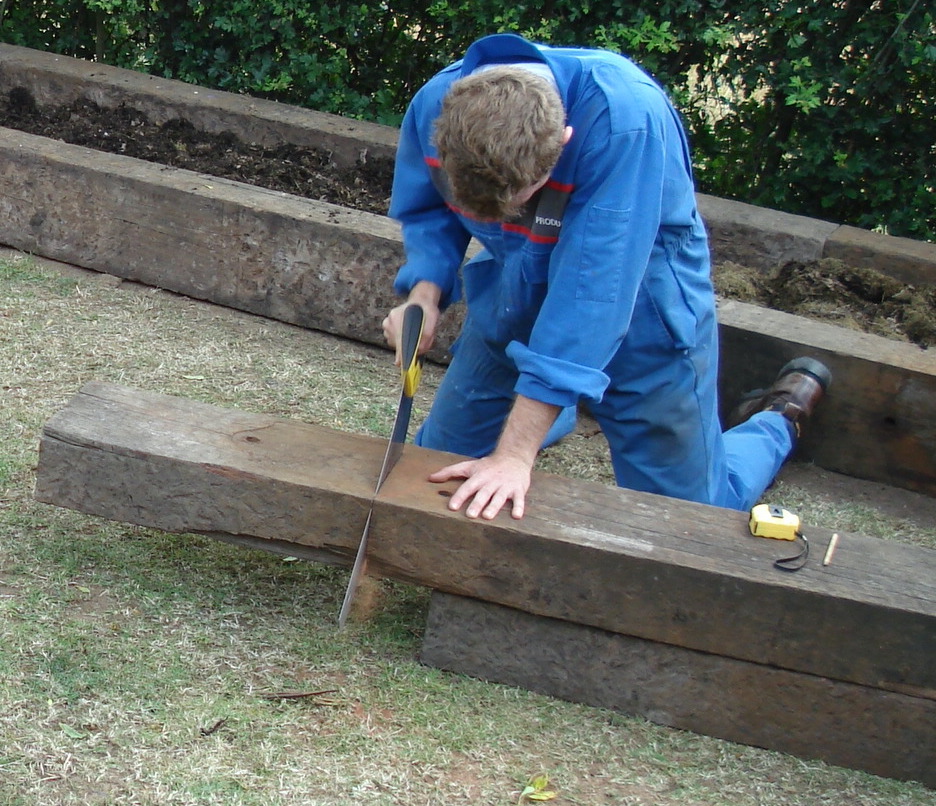 However, when it comes to cutting oak and tropical hardwoods it can be seriously hard work, not to mention as time consuming as a serious gym workout. Allow 5-10 minutes per cut, and use a fine toothed saw with plenty of elbow grease!
However, when it comes to cutting oak and tropical hardwoods it can be seriously hard work, not to mention as time consuming as a serious gym workout. Allow 5-10 minutes per cut, and use a fine toothed saw with plenty of elbow grease!
2) Circular Saw
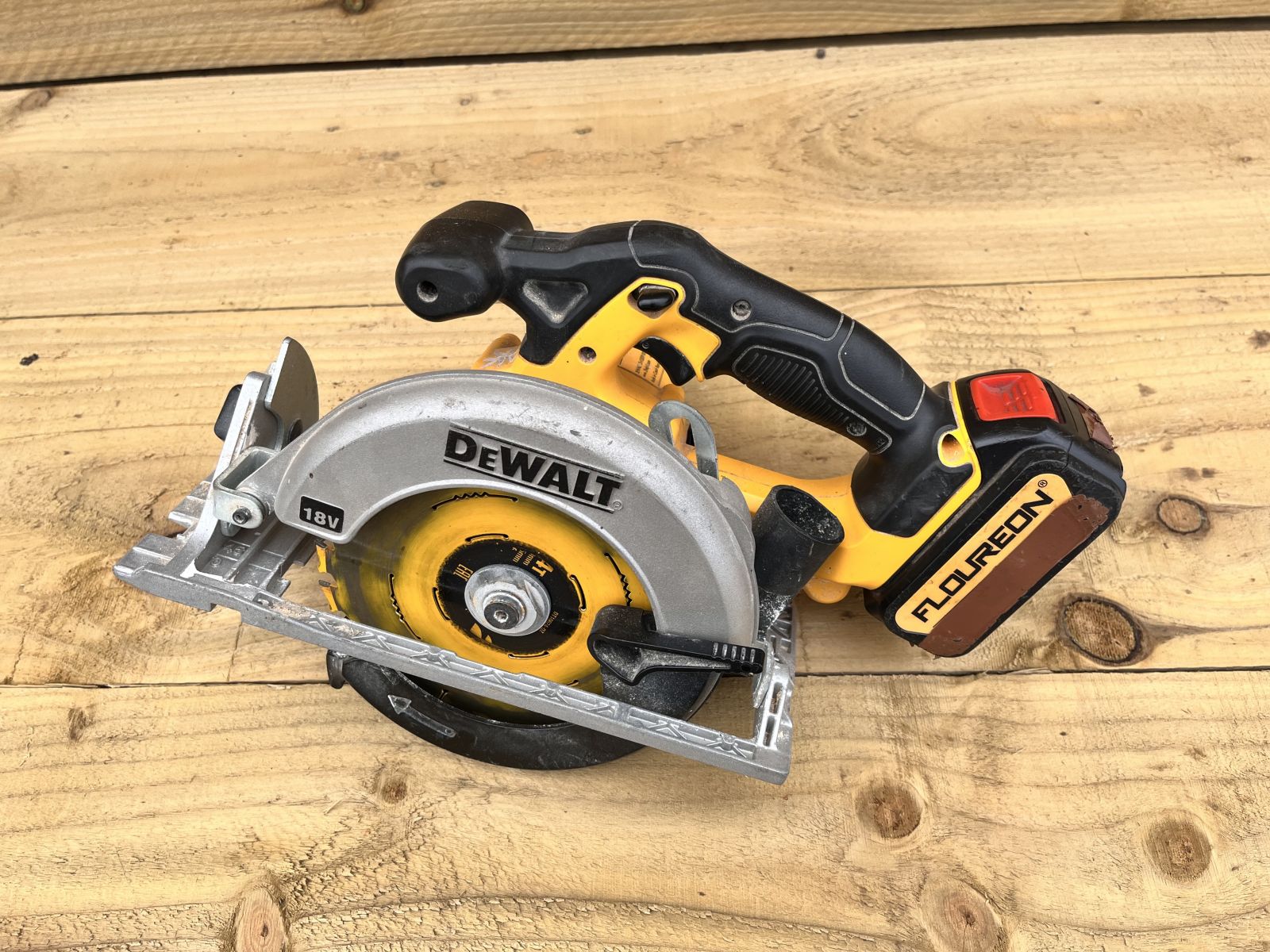 A circular saw is the most widely used DIY method for cutting railway sleepers at home. Even though it's the most accurate method for cross-cutting railway sleepers you will normally find that the usual 50mm-75mm blade is not deep enough to cut through the railway sleeper in one go. Instead, the railway sleeper will need to be flipped and additionally cut from the opposite side, which should then cut the timber in two, or possibly leave a tiny sliver of timber in the middle to finish off with a handsaw. You should ended up with pretty neat cuts after a bit of practice. A premium quality tungsten carbide blade is a good investment and is still serviceable after well over 100 cuts. Remember to wear protective gear such as gloves, goggles and hearing protection
A circular saw is the most widely used DIY method for cutting railway sleepers at home. Even though it's the most accurate method for cross-cutting railway sleepers you will normally find that the usual 50mm-75mm blade is not deep enough to cut through the railway sleeper in one go. Instead, the railway sleeper will need to be flipped and additionally cut from the opposite side, which should then cut the timber in two, or possibly leave a tiny sliver of timber in the middle to finish off with a handsaw. You should ended up with pretty neat cuts after a bit of practice. A premium quality tungsten carbide blade is a good investment and is still serviceable after well over 100 cuts. Remember to wear protective gear such as gloves, goggles and hearing protection
3) Chainsaw
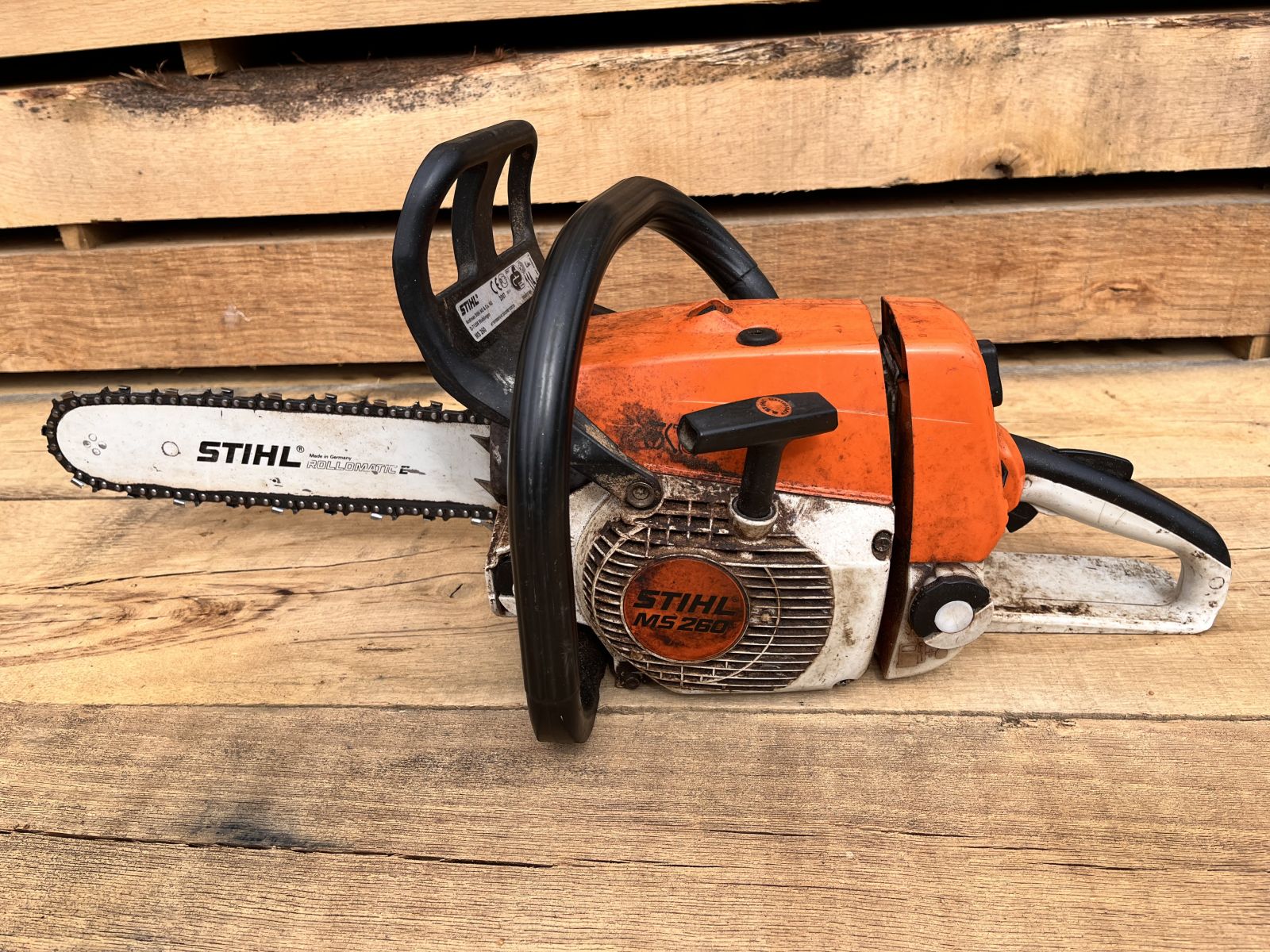 A chainsaw is a very effective and powerful way of cutting railway sleepers, and has been used for felling trees and logs for more than a hundred years. But please be aware that it can be extremely dangerous in inexperienced hands. You don't need a licence to operate one, but several people a year are killed by using them. Personally I would advise that you go on a course or take advice from an experienced practitioner before being let loose on a chainsaw. The golden rules of using a chainsaw is that you always wear gloves, helmet, ear defenders and visor, chainsaw boots and leggings. It may sound excessive, but the damage a chainsaw can do is enormous. Avoid using the upper tip of the chainsaw blade which can cause 'Kickback' of the blade into your body. Pretty messy.
A chainsaw is a very effective and powerful way of cutting railway sleepers, and has been used for felling trees and logs for more than a hundred years. But please be aware that it can be extremely dangerous in inexperienced hands. You don't need a licence to operate one, but several people a year are killed by using them. Personally I would advise that you go on a course or take advice from an experienced practitioner before being let loose on a chainsaw. The golden rules of using a chainsaw is that you always wear gloves, helmet, ear defenders and visor, chainsaw boots and leggings. It may sound excessive, but the damage a chainsaw can do is enormous. Avoid using the upper tip of the chainsaw blade which can cause 'Kickback' of the blade into your body. Pretty messy.
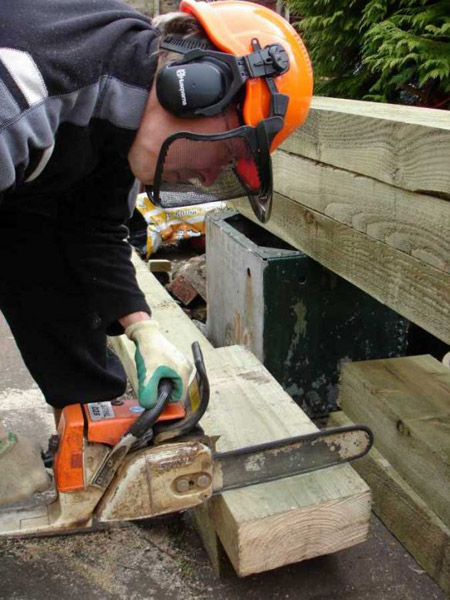 Start with a new chain, or at least a chain that is extremely sharp. If the chainsaw is struggling to cut a railway sleeper, then it is blunt, will not cut straight and is an accident waiting to happen. Re-sharpening your chainsaw on site is cheap and invaluable. We are amazed at how many landscapers pay £10 or £15 in a chainsaw shop every time their chainsaw blades get blunt (which can be pretty often if you do a lot of cutting or hit stones or nails etc..). Why lose money and the use of your chainsaw when you can sharpen it yourself on the job in 5-10 minutes, for less than 50p. That's all it costs. One round file for about £2 will sharpen your saw 4 times or more. A Stihl chainsaw filing kit will cost you about £12. (Canvas case with round file, flat file, file holder & file gauge). It's not rocket science!
Start with a new chain, or at least a chain that is extremely sharp. If the chainsaw is struggling to cut a railway sleeper, then it is blunt, will not cut straight and is an accident waiting to happen. Re-sharpening your chainsaw on site is cheap and invaluable. We are amazed at how many landscapers pay £10 or £15 in a chainsaw shop every time their chainsaw blades get blunt (which can be pretty often if you do a lot of cutting or hit stones or nails etc..). Why lose money and the use of your chainsaw when you can sharpen it yourself on the job in 5-10 minutes, for less than 50p. That's all it costs. One round file for about £2 will sharpen your saw 4 times or more. A Stihl chainsaw filing kit will cost you about £12. (Canvas case with round file, flat file, file holder & file gauge). It's not rocket science!
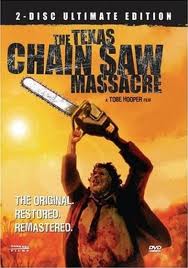 Avoiding the bloodbath of chainsaw massacres. Who are we to criticise fellow professionals, but really...! Some of the knackered saws that we've seen with dangling blunt blades, and users who strain life and limb to cut railway sleepers with the top tip of the saw (one of the definite NO's in chainsawing, and a deadly invitation for 'kick-back'). Please be careful out there. Consider a chainsaw course if you haven't taken one. You'll learn how to stay alive, as well as sharpening, changing chains and servicing. It'll also give you a licence to use it in a public place. Well worth it.
Avoiding the bloodbath of chainsaw massacres. Who are we to criticise fellow professionals, but really...! Some of the knackered saws that we've seen with dangling blunt blades, and users who strain life and limb to cut railway sleepers with the top tip of the saw (one of the definite NO's in chainsawing, and a deadly invitation for 'kick-back'). Please be careful out there. Consider a chainsaw course if you haven't taken one. You'll learn how to stay alive, as well as sharpening, changing chains and servicing. It'll also give you a licence to use it in a public place. Well worth it.
4) Reciprocating saw
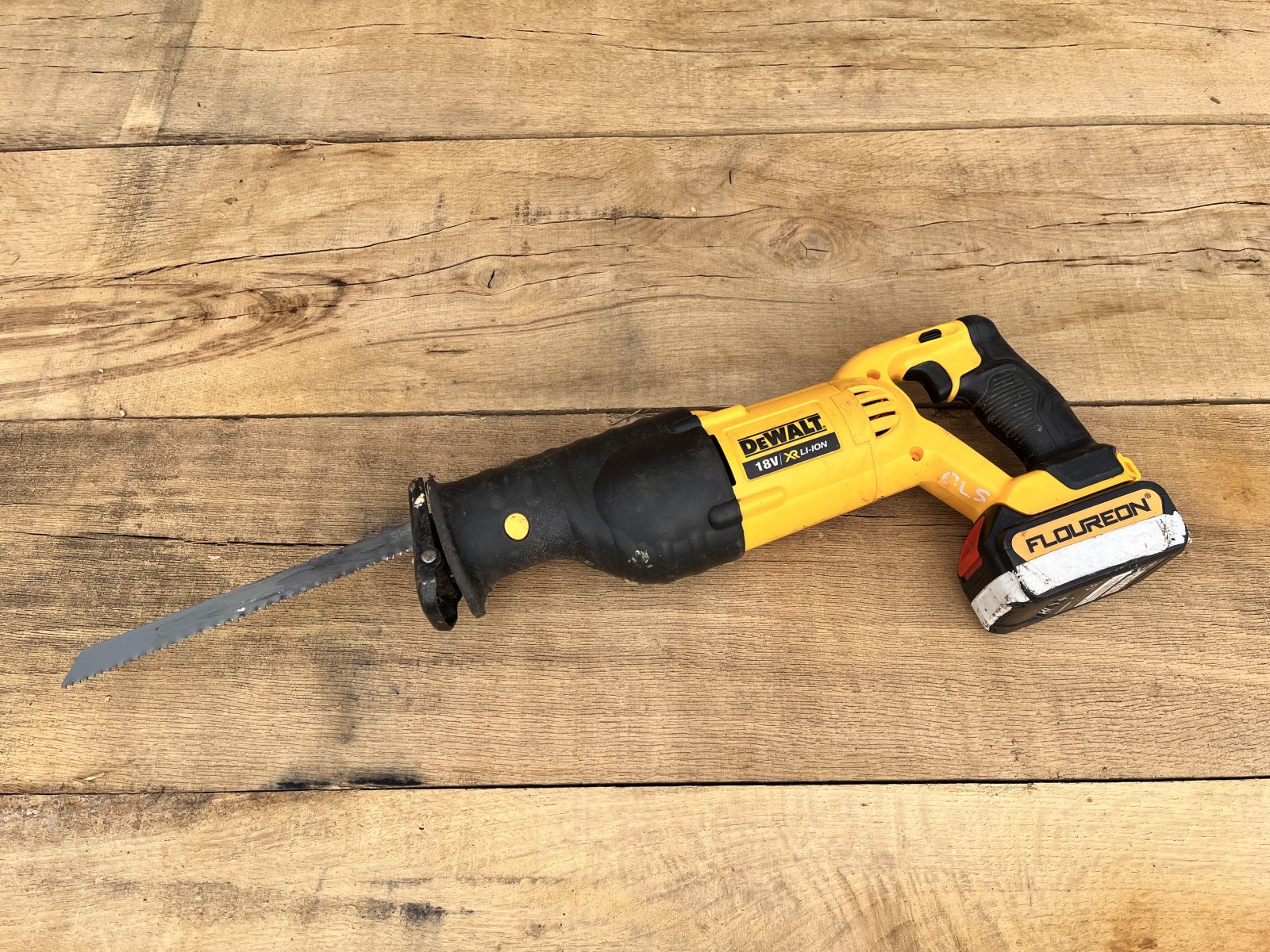 Back in the 1960's the latest kitchen 'must have' was an electric bread slicer. You could be the envy of your friends as you proudly served up freshly sliced bread. Those impressive days are gone, and the primary use of a reciprocating saw with its horizontal blade action is for rough construction & demolition work, such as cutting wood, metal and plaster. They combine power, manoeuvrability, and the ability to cut through a variety of materials.
Back in the 1960's the latest kitchen 'must have' was an electric bread slicer. You could be the envy of your friends as you proudly served up freshly sliced bread. Those impressive days are gone, and the primary use of a reciprocating saw with its horizontal blade action is for rough construction & demolition work, such as cutting wood, metal and plaster. They combine power, manoeuvrability, and the ability to cut through a variety of materials.
Safety tips to follow when using a reciprocating saw to cut railway sleepers
1) Wear impact-resistant safety goggles.
2) Use a sharp blade designed for cutting timber.
3) Keep hands away from the blade.
4) Hold the tool with both hands.
5) Watch the Electrical Cord, unless it's cordless.
Which railway sleepers are easiest / hardest to cut?
Easiest level: 'Straightforward. The easiest of all our railway sleepers to both lift and cut'.
British pine railway sleepers are the easiest railway sleepers to cut. Even a handsaw would be fine, if need be.
Medium level: 'A little more effort required, but nothing to be worried about'.
New oak railway sleepers are slightly heavier and harder to cut than new pine, but still very achievable.
Harder level: 'These are tougher to cut, especially the 250mm x 150mm thickness. Definitely more of a slog!'
Used Dutch oak and used Belgium oak are much more of a struggle, and you will need a more professional or powerful saw and plenty of determination.
Toughest level: 'Not for the faint hearted. Seriously tough to get through, but you'll feel great afterwards!'
Jarrah and Azobe tropical hardwood railway sleepers are heavy, tight grained, and can sometimes feel like cutting through concrete. You will need a very sharp, powerful cutting tool to get through these mighty railway sleepers. Make sure you frequently re-sharpen or change the blade. Good luck!
Urban myths
.jpg) There is an urban myth that states that it's dangerous to cut European railway sleepers because they have bullets embeddied in them. Apparently, so they say, the RAF and Luftwaffe sprayed railway tracks with machine gun fire, for target practice, during WW2. However Richard Watson has exposed this myth with simple logic: "Even if you found a bullet it wouldn’t be dangerous as it is the cartridges which are explosive not the bullets!" He carries on: "I did find this in a railway sleeper I was working with yesterday, luckily when denailing rather than cutting". Hardly a bullet!
There is an urban myth that states that it's dangerous to cut European railway sleepers because they have bullets embeddied in them. Apparently, so they say, the RAF and Luftwaffe sprayed railway tracks with machine gun fire, for target practice, during WW2. However Richard Watson has exposed this myth with simple logic: "Even if you found a bullet it wouldn’t be dangerous as it is the cartridges which are explosive not the bullets!" He carries on: "I did find this in a railway sleeper I was working with yesterday, luckily when denailing rather than cutting". Hardly a bullet!
Can you believe it?
An older customer returned to Nottingham to pick up some more of the new 2.6m x 250mm x 125mm French oak railway sleepers, that he'd used to create the effect of beams in his kitchen. He said in passing that he'd planked one, and that it looked brilliant. "How did you cut it ?", we asked. "By hand", he replied proudly. He'd cut it with a hand saw and it had taken 10 hours. Astonishing determination !
VOTE OF CONFIDENCE!
Please help us spread the word! If you've found our website helpful or inspiring please leave feedback or 'Like us' on Facebook, Instagram or Twitter. A simple way of letting people know "This is a really useful website!" Thanks



BUY ONLINE or
RING DIRECT

0115 9890445
enquiries@railwaysleepers.com
WHICH
RAILWAY SLEEPERS ARE
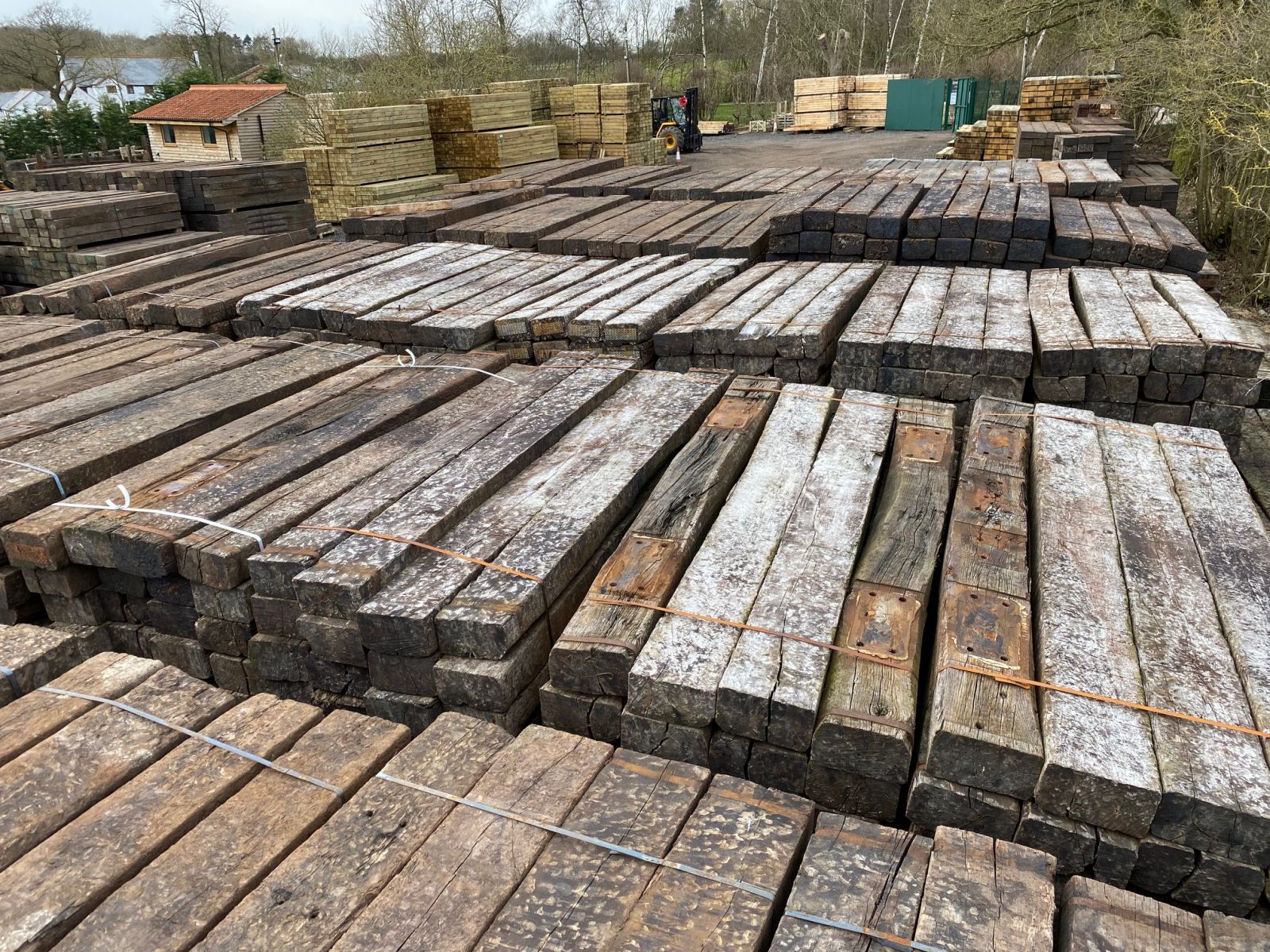
THE BEST?
JUST A CLICK CLICK CLICK AWAY
INSPIRATION?
NEED IDEAS?



CLICK for the WORLD'S
LARGEST COLLECTION of
RAILWAY SLEEPER PROJECTS
SHARE
your project and creation

SEND your PHOTOS to
enquiries@railwaysleepers.com
or WhatsApp 07816 959310
CONFUSED?
Need some advice?

CONTACT US & we'll help you
work out what items you need.
0115 9890445




